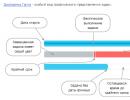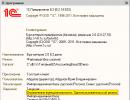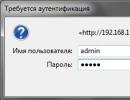Notes on computer science on the topic "style formatting" (7th grade of the Federal State Educational Standard). Using styles to format a document Style formatting in Word
Lesson summary Style formatting (8th grade, lesson 24, textbook by L.L. Bosov). The lesson expands and systematizes ideas about formatting document pages.
Planned educational results:
— subject– an idea of text formatting as a stage of creating a text document; an idea of style formatting; understanding of different text formats;
— meta-subject– a wide range of skills and abilities in using information and communication technologies for creating text documents; skills of rational use of available tools;
— personal– understanding the social and general cultural role of skilled keyboard writing skills in the life of a modern person.
Solvable educational tasks:
1) formation of ideas about style formatting;
2) expansion and systematization of ideas about formatting document pages (page orientation, margins, page numbers, footers);
3) formation of ideas about the variety of text file formats.
Basic concepts studied in the lesson:
— formatting;
- style;
- page settings;
— text file formats.
ICT tools used in the lesson:
— Personal Computer(PC) teachers, multimedia projector, screen;
— Students’ PCs.
Electronic educational resources
— presentation “Style Formatting”;
— federal resources educational portals:
1) animation “Styles in MS Word”,
2) animation “Templates in MS Word”.
Features of presenting the content of the lesson topic
1. Organizational moment (1 minute)
Greeting students, communicating the topic and objectives of the lesson.
2. Repetition (5 minutes)
1) checking the studied material according to questions (1-3) to §4.3;
2) visual check of homework completion in the Republic of Tatarstan: 182-187;
3) consideration of tasks that caused difficulties in completing homework.
3. Learning new material (20 minutes)
New material is presented accompanied by the presentation “Style Formatting”.
1 slide- title of the presentation;
2 slide- keywords;
- formatting
- style
- page settings
- text file formats
3 slide- general formatting information (scheme);
Text formatting- the process of its registration.
Main Purpose of Formatting— make the perception of the finished document simple and pleasant for the reader.
Style formatting— structural elements (headings, body text, examples).
4 slide- style formatting (scheme);
Small documents can be formatted using direct formatting. When working with large texts, as a rule, use style formatting. The meaning of this operation is that structural elements that carry the same functional load (for example, headings of the same level, main text, examples, etc.) are assigned a certain formatting style - a set of formatting parameters (font, its style and size, first line indentation, line spacing, etc.).
Style formatting has a number of advantages over direct formatting:
— saves time- applying a style as a set of formatting parameters is much faster than setting the corresponding parameters one by one;
— ensures uniformity in the design of a text document- with direct formatting, structural elements with the same functional purpose may differ in their formats; the use of a certain style brings rigor to the design of the document;
— allows you to quickly change the appearance of individual elements throughout the document- just make changes to the style, and the design will be changed throughout the document.
You can create your own styles or use ready-made styles available in your word processor. Based on certain styles, they are created templates standard documents - booklets, letters, business cards, invoices, resumes, business letters, reports, etc. The user just needs to enter his information in separate blocks of the template, and it will automatically acquire a predetermined design.
View and discuss the animation “Styles in MS Word”.
View and discuss the animation “Templates in MS Word”.
5 slide- formatting document pages (scheme);
When creating a text document intended for printing, Special attention You should pay attention to its location on sheets of paper.
In most cases, A4 size paper (210 x 297 mm) is used.
User can choose orientation of the sheet of paper:
— book- the height of the sheet is greater than its width;
— landscape- the width of the sheet is greater than its height.
The text of the document is placed on the page in the print area limited by the margins. Fields represent the empty space at the edges of the page. Distinguish top, bottom, left and right margins. Page numbers and headers and footers are placed in the margins. Running title- auxiliary information that is displayed on each page of the document.
Tell us about the basic requirements for preparation of the abstract.
Basic requirements for the preparation of an abstract.
The abstract must be written on one side of sheets of white A4 paper (210 x 297 mm).
Page margin sizes (minimum):
- right - 30 mm (for teacher comments),
- top, bottom, left 20 mm each.
First line indent: 8-12 mm, the same throughout the text.
Line spacing: one and a half.
Paragraph alignment: justified.
The font typeface for the main text is Times New Roman or similar.
Point size (size): 12-14 points.
Font color: black.
Section and subsection headings should be printed on a separate line with a capital letter without a period at the end, without underlining. Center or left alignment. Spacing: before the heading - 12 points, after - 6 points.
Pages should be numbered in Arabic numerals, observing continuous numbering throughout the text (the title page and table of contents are included in the general numbering). There is no number on the title page.
At the top of the title page it is written in which educational institution the work is being carried out, then in letters of larger size the type (“Abstract”) and the topic of the work are indicated, below in the right half of the sheet is information about those who completed and who checks the work. In the center of the bottom of the title page is written the name of the locality and the year the work was completed.
6 slide- saving documents in various text formats (scheme);
When you save a text document in a file on external media, the text itself and its formatting commands are saved. When reading a text document, the processor reads the text and its formatting commands, executes those commands, and displays the formatted text on the screen.
The most common file formats are:
save text documents:
— TXT - saves text without formatting, only end-of-paragraph control characters are inserted into the text;
— DOC - proprietary document format Microsoft Word;
— ODT - proprietary document format of OpenOffice.org Writer;
— RTF is a universal format that preserves all formatting; converts control codes into text commands that can be read and interpreted by many applications; compared to other formats, it has a fairly large information volume;
— HTML is the format used to store Web pages;
— PDF is a format intended for presentation in in electronic format printed documents; ensures correct display of the document regardless of the operating system.
7 slide- the most important.
Text formatting— the process of its registration; the perception of the document becomes simpler due to the isolation and identical design of similar structural elements of the text. There are:
- direct formatting;
- style formatting.
Character Formatting— changing the values of the properties of the entered characters: font, size, style, color, etc.
Paragraph formatting— changing properties such as alignment, first line indent, line spacing, left and right indents, spaces before and after, etc.
Main document page parameters are paper size, page orientation, and margin size.
The most common file formats in which text documents are saved are: TXT, DOC, ODT, RTF, HTML, PDF.
Questions and tasks
8 slide– questions and assignments.
Questions 4, 7, 9 to paragraph 4.3
RT: No. 188, 189.
4. Practical part (15 minutes)
In the practical part of the lesson, students continue to complete tasks 4.10-4.16 from the tasks for practical work for Chapter 4.
5. Summing up the lesson. Homework message. Grading (4 minutes)
Slide 9- supporting summary;
10 slide- D/z.
Homework.
§4.3 (4, 5, 6), questions and tasks 4-9 to the paragraph,
RT: No. 188, 189.
All material for the lesson is in the archive.
The archive includes:
- summary,
- answers and solutions to tasks in the workbook,
— basic requirements for the preparation of an abstract,
— presentation “Style Formatting”,
— animation “Styles in MS Wosd”,
— animation “Templates in MS Wosd”.
Download(1.81 MB, rar): Lesson summary
Style is a set of formatting parameters that has its own name.
In order for the text to be easy to read, it must be formatted accordingly: highlight headings, arrange subheadings in accordance with their level, caption figures and tables, highlight new terms, notes, set headers and footers, etc. Format each element manually is time-consuming and ineffective. With styles, you can set multiple formatting options in one step. In this case, for each design element you can set your own style, which will have a unique name. It is enough to install the required styles, and then each time simply select the required one from the list.
Using styles can improve efficiency and speed up work.
In MS Word, a style can be applied to an entire paragraph or to several characters.
The default main style is Ordinary . This style is used for the body text of any document and serves as the basis for creating other styles. Formatting options can be found in the style description contained in the dialog boxes. Style, Changing the style, Creating a style, Organizer. All of the dialog boxes listed above contain a section Description, which presents all format parameters.
Setting styles
The dialogue window provides the most extensive opportunities for working with styles. Style. To set the style using the dialog box Style you need to do the following:
1. Place the cursor within the text fragment in which you want to change the style.
2. Select a team Format –> Style. A dialog box will open Style(Fig. 4.28).
3. Listed Style select the required style.
4. Press the button Apply.
Using the dialog box Style you can also:
- change existing styles;
- create new styles;
- remove custom styles that have become unnecessary;
- copy the required styles from one template to another.
Rice. 4.28. Dialog window Style.
Headings rarely include headings at all levels. A table of contents that contains the names of all parts of a document may look overwhelming. On the other hand, a table of contents that contains only top-level headings provides too little information about the contents of the document.
To create a table of contents you must perform the following steps:
1. Place the cursor within the text in which you want to create a table of contents.
2. Select a team Insert –> Table of Contents and Indexes. A dialog box will open Table of contents and indexes(Fig. 4.29).
3. Go to tab Table of contents.
4. In the field Format select the table of contents presentation method in the field Levels – level of included headings, and in the field Placeholder – padding characters between titles and page numbers.
5. Press the button OK.

Rice. 4.29. Inclusion in the table of contents of levels 1-3
After pressing the button OK A compiled table of contents will appear on the screen, which you can later edit and format.

Rice. 4.30. Ready table of contents, including headings of three levels
Autoformat
Autoformat can format a document without user intervention. MS Word parses the document, identifies individual elements, and then formats the text using the styles of the included template.
Autoformatting can be done both as you enter text and after you enter it. In this case, the user reserves the right to accept or reject the formatting produced using the auto-format. In addition, you can partially accept, and partly changes made- refuse.
Using Styles in Microsoft Word can automate document formatting and save you time, which will significantly impact your productivity while working on documents. If you want to learn quick formatting text, then follow the basic steps described below.
Step 1: Apply styles to sections of unformatted documents.
Sometimes text or a section of text in a document may not look the way you want, and to transform it you need to select the desired fragment, go to the “Styles” menu and select the desired style to apply.
Step 2: Quickly Change an Existing Style
Step 3: Create a Table of Contents with Styles
When writing multidisciplinary scientific articles or book chapters, you may need to use tables of contents, which in this case are important as they help in navigating the contents of the document.
To set the table of contents, do the following:
- Place the cursor on the part of the document where you want to place the table of contents.
- Click the Links tab, then click Table of Contents.
- Notice the dialog box that appears. The “Auto-assembled table of contents 1, 2” options will speed up the creation process. "Manual table of contents" makes it possible detailed settings, but it will take longer to install.
- Check out the Custom Table of Contents option. Once you select it, you can use styles to change the way the table of contents is displayed by clicking "Edit".
- If your table of contents has multiple levels, select the one you want to change.
- You will then see a dialog box used when changing the style. Change the specifications if necessary, then click OK.
As you can see, working with text or styles can save time. You only need to make changes to the “Styles” or “Tables of Contents” once and then use it as a template, applying it to the necessary fragments of text or the entire document.
Video: Formatting a document in MS Word 2003. Working with styles
Topic 2.4. Database management systems and expert systems
2.4.11. Training database with the main button form "Training_students" - Download
Microsoft Word - word processor
2.1. Processing of text information. Word processors
2.1.3. Text document formatting and styles in Word
Formatting a text document
Formatting a document is changing its appearance. WORD provides document formatting at five different levels:
- at the character level (changing typeface, style, font size and color, letter spacing in a word, animation, etc.);
- at the paragraph level (left, right, center and justified alignment; right and left indents; first line indent; indents before and after paragraphs; line spacing, pagination control, etc.);
- at the page level (page settings, page orientation, frame, headers and footers of the first page, even and odd pages, etc.);
- at the section level (forming sections from the next page or on the current page, dividing text into columns, etc.);
- at the document level (page numbers, table of contents, etc.).
A paragraph is a piece of text that ends with a non-printable character or a piece of text whose input process ends by pressing the Enter key. A paragraph includes: body paragraph, headings, table of contents, lists (numbered and bulleted), etc.
To format characters, use the Font dialog box (Format / Font) or commands on the formatting toolbar. Paragraphs are formatted using the Paragraph dialog box, which opens with the Format / Paragraph command.
You can view the formatting of the selected text in the task pane by running the Format / Show Formatting command.
Styles
Styles are intended for the external design of a document and its paragraphs, i.e. styles are used to format a document. A style is a set of formatting commands that is stored under a unique name for repeated use. Formatting text using a style is much faster than manually formatting each element of text, because one command (style) automatically formats a group of text options.
There are three main types of styles:
- A character style contains character formatting options, including font, size, style, position, and spacing.
- A paragraph style contains paragraph formatting options, such as line spacing, indentation, alignment, and tab stops. Paragraph styles can also contain character styles or formatting options. Most of the styles used in Word are paragraph styles.
- The table style contains table formatting parameters (when a table is inserted, it is assigned a default style - table grid).
When you create a new document based on the Normal template, it receives a copy of the set of styles from the base set of general-purpose styles (from the built-in styles): Normal, Headings 1, 2, 3.
After entering text into a document is completed and the text has been edited, it is advisable to use the AutoFormat command to change the appearance of the entire document.
When you automatically format a document, each paragraph is assigned one of Word's styles. For example, a heading can be assigned the Heading 1 or Heading 2 style, a body paragraph can be assigned the Body Text style, and a paragraph included in a list can be assigned the List style. Notes are assigned the Text Note style, headers are assigned the Header style, page numbers are assigned the Page Number style, and so on.
Assigning standard Word styles to paragraphs in a document allows you to quickly change the appearance of the created document by applying styles from the style library. Built-in styles provide formatting for headings at various levels and allow you to view the hierarchical structure of a document in structure mode, as well as quickly build a table of contents.
Additionally, if most paragraphs in your document use the Body Text style rather than the Normal style, you can easily reformat just the body text style without affecting the style of the rest of the text.
Operations with styles in the Styles and Formatting task pane
Styles can be changed and new ones created. In addition, you can apply a different style (overlay a style) to already formatted text, i.e. reformat it.
To do this, select the Format / Styles and Formatting command, the task pane will appear in the “Styles and Formatting” mode. Place the cursor in the text you want to reformat, and in the task pane, under “Select formatting to apply,” click on the desired style, the paragraph under the cursor is reformatted to the selected style.
If you need to change the style or create a new style, then place the cursor in the text whose style you want to change; in the task pane, in the “Formatting selected text” section, the text style under the cursor will be displayed. Next, you need to move the mouse pointer to the name of the style and click on the arrow that appears on the right, a list of commands will open: Clear format, Change style, Create style. Select the required command (change or create a style), a corresponding dialog box will appear in which you can change or create a style.
The Normal style is the basis for most other paragraph styles, so changing the Normal style will change all styles based on it. The Normal style is not based on any of the styles.
Rice. 1.

Rice. 2.
Elements of text documents that are entered into a document during the process of editing and formatting:
- Header/Footer (View/Header/Footer).
- Symbol (Insert/Symbol).
- Reference (footnotes; names of figures, tables, formulas; cross-references; table of contents and indexes). Called by the Insert / Link command.
- Note (Insert/Note).
- Hyperlink (Insert / Hyperlink).
- Bookmark (Insert / Bookmark).
- Backgrounds, backgrounds and themes (Format / Background, Format / Theme).
A footer is text or a picture (page number, document printing date, document title, author's name, picture, etc.) that is printed at the bottom or top of each document page. Depending on the location (on the top or bottom margin of the page), there are headers and footers.
To create a header and footer, you need to run the View / Header and Footer command. Headers and footers, like the document background, as well as margins, page size and orientation, page numbers, page breaks, and section breaks, refer to changes in the appearance of pages and the document.
Check spelling (spelling and grammar) in Word
Spell checker (spelling checker) is an editor tool that allows you to check and correct the spelling of words in a document. The editor compares the words in the document being checked with a dictionary, and unknown words are highlighted. After this, you can skip the word, correct it, or add it to the dictionary.
Checking grammar is checking the grammatical and stylistic rules of writing (inconsistency between subject and predicate, incorrect prepositional combinations).
There are several ways to check spelling:
- Check spelling and grammar as you enter text.
- Manual spelling and grammar checking.
To set up automatic spelling and grammar checking, do the following: Select Tools/Options and in the window that appears, click on the Spelling tab. Check the Automatically check spelling and Automatically check grammar checkboxes.
To manually check spelling and grammar, select the Tools/Spelling command; the Spelling dialog box will appear, with which you can perform the required check.

Rice. 3.
View and print a document
Depending on the tasks you perform in Microsoft Word 2003, you can select different document viewing modes:
- Layout mode.
- View mode.
- View.
Layout modes are used when working on a document; this mode includes: Page Layout, Web Document, Normal, Structure.
Viewing modes are used to read a document and move around in it; this mode includes: Reading Mode, Thumbnails, Document Outline.
Preview is used to display the appearance of the document in the publication form, this mode includes: Web Page Preview, Preview.
Preview mode is useful for viewing several pages of a document in a reduced form. In this mode, you can view page breaks and the background, and change the content or formatting of the document before it is printed.
Before printing a document, you should check it appearance, by issuing the command File – Preview or clicking the Preview button on the toolbar. To exit preview mode, click the “Close” button.
To print a document using the default printer settings and print settings, click the Print button in the preview window or on the standard toolbar.
To select a printer and print settings, select the Print command from the File menu, and the Print dialog box will appear.

Rice. 4.
In the Printer area, select the required printer from the list provided.
In the Page area, you should specify which part of the document to print: the entire document; current page; selected fragment or several pages with specified numbers.
The number of copies is specified in the Number of copies field.
Select the Enable: All Pages in Range option or print all odd-numbered pages first, followed by even-numbered pages.
The scale option group allows you to specify printing of several pages of text on one sheet of paper.
Row additional parameters Print settings can be specified by clicking the Options button.
Creating large documents differs in many ways from creating one-page documents.
This is due to different design requirements for different types of publications. So many books, each scientific and technical report or thesis must contain page numbers, a table of contents, indexes, footnotes and references, as well as some other elements of the publication apparatus.
Word provides an efficient means of designing multi-page documents.
To unify the design of parts of large documents, styles should be used. Carry out style
formatting can be done while entering text (the style is assigned after entering a paragraph) or after typing the entire document.
Word has styles for formatting not only the main text, but also footers, footnotes, headings, etc. If you use standard heading styles, you can automatically create a table of contents.
Style formatting
Style
A group of parameters that has a unique name is called. A formatting style can contain many different parameters for paragraphs and characters (for example, font type and size, paragraph alignment, paragraph spacing, borders, etc.). It is stored with the document or its template.
Style formatting involves assigning styles to paragraphs or characters. Style formatting makes it easier to prepare documents (the user operates with ready-made styles), saves time and achieves unification of the design of all documents used in a particular organization. Style Style formatting uses two types of styles: character styles and paragraph styles. Character styles are designed to design selected fragments within a paragraph (characters, words, phrases, sentences).
Paragraph styles are used to format entire paragraphs. If you position the insertion cursor within a fragment to which a character style is assigned, the name of that style appears in the list of styles in the formatting toolbar. If the character style is not formatted Style used, listed The name of the paragraph style is displayed. Character styles are indicated in the list by an underlined letter a, and paragraph styles are indicated by a paragraph marker. Default list
on the tab Style home The name of the paragraph style is displayed. Character styles are indicated in the list by an underlined letter a, and paragraph styles are indicated by a paragraph marker. contains the names of only those styles that were used in the document. In the command dialog you can change existing styles and create new ones, copy, delete and rename styles, and also assign styles to selected text fragments (Fig. 1)
Figure 1 – Group Styles
Built-in formatting styles
Word provides standard styles for designing common documents. When you enter the text of a new document that
based on template Ordinary, default style is used Ordinary- standard style for the main text. This style is applied until another style is specified. Special styles have also been developed for formatting other elements of the document (footnotes, headers and footers, line numbers, page numbers, etc.).
For example, styles are used to format headings Heading1 - Heading9.





